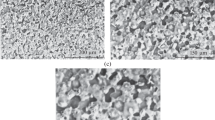Abstract
The addition of short, bare, carbon fibres to a silver-based active brazing alloy (63Ag-34Cu-2Ti-1Sn) resulted in up to 30% improvement in the shear/tensile joint strength of brazed joints between stainless steel and alumina. The optimum fibre volume fraction in the brazing material was 12%. This improvement is attributed to the thinning and microstructural simplification of the alumina/braze reaction product (titanium-rich) layer, the softening of the brazing alloy matrix, the strengthening of the braze and the reduction of the coefficient of thermal expansion. The depth of titanium diffusion into the alumina was decreased by the fibre addition. The first two effects are due to the absorption of titanium by the fibres. This absorption resulted in less titanium in the brazing alloy matrix, a braze/fibre particulate reaction product (titanium-rich) on the fibres and the diffusion of titanium into the fibres. In contrast, the use of an active brazing alloy with a lower titanium content but without carbon fibres gave much weaker joints.
Similar content being viewed by others
References
“Metals Handbook”, Vol. 6, “Welding, Brazing and Soldering”, 9th Edn (Handbook Committee, American Society for Metals, Metals Park, Ohio, USA, 1983)
L. VEGARD, Z. Physik 5 (1921) 17.
H. MIZUHARA and K. MALLY Weld J. 64(10) (1985) 27.
W. WEISE, W. MALIKOWSKI and W. BOHN, Ceram. Ind. 134(2) (1990) 38.
M. L. SANTELLA, J. A. HORTON and J. J. PAK, J. Am. Ceram. Soc. 73 (1990) 1785.
G. ECONOMOS and W. D. KINGERY, ibid. 36 (1953) 403.
P. R. KAPOOR and T. W. EAGAR, ibid. 72 (1989) 448.
R. E. LOEHMAN and A. P. TOMSIA, Am. Ceram. Soc. Bull. 67 (1988) 375.
M. G. NICHOLAS and D. A. MORTIMER, Mater. Sci. Technol. 1 (1985) 657.
JOSEPH R. McDERMID and ROBIN A. L. DREW, J. Am. Ceram. Soc. 74 (1991) 1855.
Studies in Physical and Theoretical Chemistry, 48, Proc. First Seiken Int. Symp. Interface Structure, Properties and Diffusion Bonding (Fundamentals of Diffusion Bonding), 1985, Yoichi Ishida, ed., (Elsevier, Amsterdam, 1987).
BRIAN C. COAD, US PAT 4 409 181 (1983).
JIMIN CAO and D. D. L. CHUNG, Weld. J. 71(1) (1992) 21.
MINGGUANG ZHU and D. D. L. CHUNG, J. Am. Ceram. Soc. 77 (1994) 2712.
M. KOYAMA, S. ARAI, S. SUENAGA and M. NAKAHASHI, J. Mater. Sci. 28 (1993) 830.
H. HAO, Y. WANG, Z. JIN and X. WANG, ibid. 30 (1995) 1233.
“Metals Handbook”, Vol. 8, “Metallography, Structures and Phase Diagram”, Taylor Lyman, ed., 8th Edn (Handbook Committee, American Society for Metals, Metals Park, Ohio, USA, 1973).
Author information
Authors and Affiliations
Rights and permissions
About this article
Cite this article
Zhu, M., Chung, D.D.L. Improving the strength of brazed joints to alumina by adding carbon fibres. Journal of Materials Science 32, 5321–5333 (1997). https://doi.org/10.1023/A:1018666827969
Issue Date:
DOI: https://doi.org/10.1023/A:1018666827969




